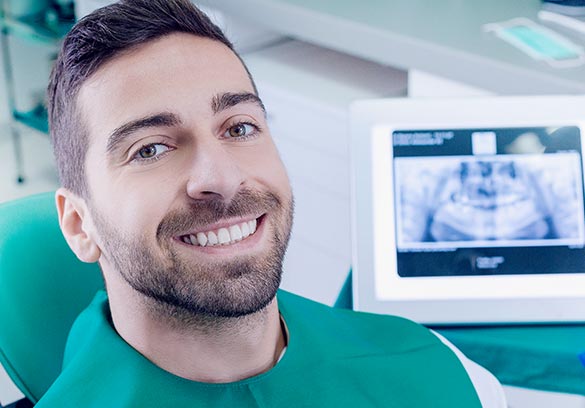Additional Services
at Rocheleau Dental
Myofascial Pain Disorder: TMJ Diagnosis & Treatment/Bruxism
It’s always frustrating to get a headache without knowing the cause. But if your headache doesn’t go away, or if it’s accompanied by other problems with your jaw, the underlying issue may be in the joints. TMJ disorder is a painful affliction that affects over 10 million people in the US, and when left unchecked, it can seriously damage your jaws and teeth.
The temporomandibular joints (or TMJ) are the joints and jaw muscles on each side of your head that help you move your jaw when you speak, chew, and swallow. Each TMJ has a disc between the ball and socket that cushions the load as the jaw opens, rotates, or glides. TMJ disorder occurs when there’s an interference in this complex system of muscles, bones, and joints. The pain that results from TMJ disorder can easily be confused with symptoms for migraines or sinus headaches.
Check with our dental professionals if you notice one or more of the following symptoms:
✓ A change in alignment of the top and bottom teeth
✓ Clicking or popping sounds when opening and closing the mouth
✓ Congestion or ringing in the ears
✓ Difficulty swallowing
✓ Locked jaw or limited opening of the mouth
✓ Pain behind the eyes
✓ Painful chewing
✓ Recurring headaches, neck aches and/or jaw pain
When you discuss these symptoms at your next appointment, there are conservative treatment plans available to alleviate your pain. Our first approach in addressing these symptoms is through relaxation techniques, gradual changes in your diet towards softer food, and the application of a warm heat pack to the affected area. In some situations, we may use a night guard to prevent teeth grinding.
Periodontal Treatment
The gums are the frames for a healthy set of teeth, and it’s important to care for both parts with daily brushing and flossing. Periodontal maintenance becomes even more important with age, as three out of four adults will be affected by gum diseases at some point in their life. More adults over age 35 lose their teeth to periodontal disease than they do to cavities.
When bacteria builds up below the gum line, the gums develop pockets (sulcus) that get filled with plaque and tartar, causing irritation to the surrounding tissues. This irritation causes the gums to recede from the teeth, which creates more space for additional bacteria that can damage the tissues and, if left untreated, can eventually reach the bone structure that supports the teeth.
There are two stages of severity in gum disease:
- GINGIVITIS: A milder and reversible form of periodontal disease that only affects the gums
- PERIODONTITIS: An advanced level of disease where infection and inflammation can lead to bone loss, tooth mobility and tooth loss.
Early detection of gum disease offers the most treatment options. If no damage has been done yet, one or two regular cleanings can help keep the gums in check, along with consistent daily oral hygiene.
In the more advanced stages of gum disease, a special periodontal cleaning called scaling and root planing may be recommended. This deep cleaning removes tartar from above and below the gum line and gets rid of the spots on the tooth where bacteria forms. This procedure can shrink the pockets and help the gum tissue heal. Medications and special medicated mouth rinses can help control the infection during the recovery period.
If the pockets don’t heal after scaling and root planing, periodontal surgery may be recommended to remove the depths of the pockets and remove deeper tartar deposits. If periodontal infection has reached the bone structure, a bone and tissue graft may be necessary to encourage new growth in the damaged bone and gum tissue.
Digital X-Rays
X-rays are an essential tool for preventing and diagnosing dental health problems beyond a regular exam. Our advanced digital imaging system provides the most accurate picture of your teeth, roots, and jaw alignment with minimal radiation. The enhanced imaging from a digital x-ray helps us diagnose diseases with speed and accuracy to ensure the highest level of treatment.

Oral Cancer Screenings
You may be aware of how important regular check-ups are to keep your teeth healthy and strong, but there’s more to oral health than just your teeth. Not only do we examine your teeth for cavities, plaque, and gum infection, but we also routinely check the gums, lips, cheek lining, tongue, and throat for signs of oral cancer. The risk for oral cancer increases past age 50, especially for smokers and heavy drinkers, but screening matters at any age. You don’t have to wait until your bi-annual check-up for a screening.
Check with your dentist if you notice any of the following signs and symptoms persisting for more than two weeks:
✓ A lump or sore area in the mouth, throat, or lips
✓ A white or red patch in the mouth
✓ Difficulty chewing, swallowing, speaking, or moving the tongue or jaw
✓ Tenderness or pain anywhere in the mouth or on the lips
✓ Unexpected weight loss
Attentiveness and regular screenings help ensure early detection, which leads to a higher chance of successful treatment.
Athletic Mouthguards
Children and adults alike can improve their physical fitness and overall health through team sports. But whether you choose to play football, basketball, ice or field hockey, roller derby, wrestling, or boxing, you don’t want to rush into the game without protecting your teeth. A high quality mouthguard is a worthy investment because healthy teeth are priceless.
A dental professional can create a durable, custom-fit mouthguard to suit your needs. While the regular boil-and-bite mouthguards available at sporting goods stores can conform to the general shape of the tooth line, a professional quality mouthguard is molded precisely to every crevice of each tooth for a perfect fit that ensures optimal safety and comfort.


Dental Extractions
Sometimes there are situations in which a tooth extraction is necessary. While it’s common for teenagers and adults get their wisdom teeth removed, there are times when an adult tooth needs to be removed because of tooth infection or severe decay. It may also be necessary to extract a tooth before orthodontic treatment to prevent the other teeth from crowding as they shift into place.
Visible teeth usually require a simple extraction, in which the dentist loosens the tooth and then removes it. A local anesthetic is applied to ensure comfort during this procedure. Your dentist will provide instructions on caring for your mouth after the extraction.
The removal of a single tooth can lead to shifting in the rest of your teeth, which can have a serious impact on your ability to speak and chew. If extraction is necessary, we will discuss which replacement option is best for you.

